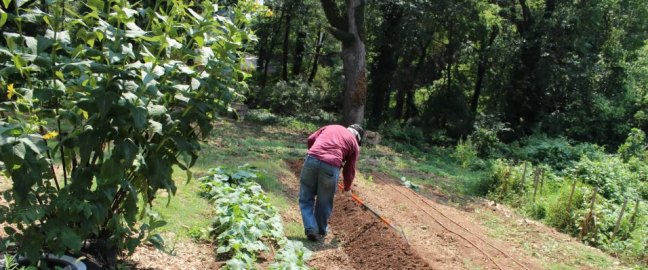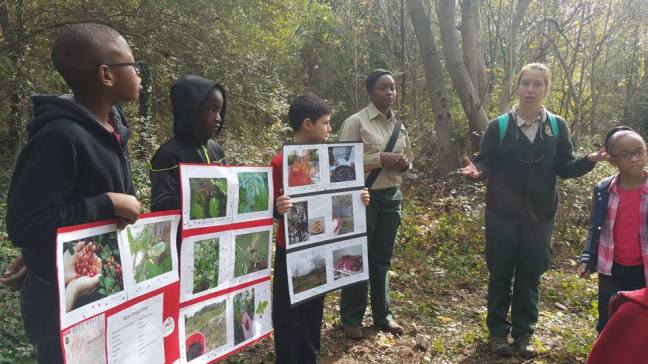By Missyllaneous
It’s no secret that urban agriculture is the new “it” project around the nation. Agriculture contributes $72.5 billion to the Georgia economy with over 42,000 farms and 9 million acres of farm land.
The benefits flow from one cause to another and we are given proof of how food brings the family together. Only this time it’s not just mom, dad, and your annoying little brother who keeps kicking you under the table (Neill, buddy, I’m glad we both outgrew that phase). No, instead it’s with our family of Atlanta, uniting government with non-profit, concrete with soil, former convicts with job employers, and people from Zone 1 with those in Zone 6. It’s beautiful. And, unfortunately, badly needed.
In case you haven’t noticed the ever growing gridlock on the connector and I-285, Atlanta’s population is projected to grow by 2.5 million over the next 25 years. That is 273 people a day! And while we are all here chasing the proverbial bread, we actually do still have to find bread and other food to eat.
In 2010 the USDA declared Atlanta was 53% food desert, making it one of the largest in the nation. Food deserts are areas, particularly lower income, where residents don’t have access to grocery stores and fresh produce for at least 1 mile surrounding. Now, 1 mile might not sound very far, but if you are dependent upon legs and public transportation all while hand carrying groceries then gravity quickly takes its toll on the entire body.
Mayor Kasim Reed, incensed, declared war and vowed by 2020 to reduce food deserts by 75% – in 2016 food deserts had already shrunk to a little over 35% of the city of Atlanta. In the last two years alone there are 11 new farms, 49 orchards, and 189 community gardens within the city limits.
Where’s the Green?

This has led to unification on all fronts with businesses and non-profits alike supporting economic growth, revitalization, and rises in property value, jobs, and education.
One example is the Better Life Growers (BLG) initiative under Community Foundation for Greater Atlanta. The initiative is all about job creation through farming of lettuce and herbs. It is shocking to learn that 98% of Atlanta’s lettuce is shipped in from California.
BLG sees an opportunity for food to be grown by training an unskilled work force in Mechanicsville where the population is 38% below the poverty line and 32 % did not graduate from high school. The goal is to grow and sell their lettuce and herbs locally starting with their own community. In the end BLG would place management and ownership of the company in the employees hands.
BLG has received state grants and partnered with JP Morgan Chase and the city has approved a $6 million loan backed by HUD.
As We Grow, Where Do We Go?

One of the major concerns of Atlanta’s rapid development and population growth is the displacement of current communities who have been there for generations. Look at Atlanta’s West End. Gentrification is evident in what is now known as West Midtown – basically people who can no longer afford Midtown and are willing to cross borders to stay near the city. Even though the West End is home to places of accreditation and history, most are familiar with stories splashed across the Metro section of the AJC and it’s rough neighborhood reputation.
Enter Rashid Nouri of Truly Living Well Center for Natural Urban Agriculture. His organization produces 30,000 pounds of food annually, 4 co-ops, 6 after school programs, and a program for persons with intellectual disabilities.
What started with 6 acres by the King Center has now been relocated to the West End. Truly Living Well moved 120 fruit tress and only lost 2 in the process (pause for applause).
“The West Side is becoming gentrified very quickly, but we have a good anchor and that is GREEN,” Nouri said at a panel discussion at the AGLANTA 2017 urban agriculture and sustainability conference last month. “We must work together to bring about integration and break down the walls.”
Seeing the Forest through the Trees

One of the newest projects is the Browns Mill Food Forest. Located just north of the Browns Mill Golf Course and southeast of Lakewood Amphitheater, the city announced an acquisition of 7.1 acres of land to be dedicated as a community food forest.
The concept and execution of food forests are still fairly new. In fact, the Browns Mill Food Forest will be the first in the state, third in the country, and the largest in the nation.
Partnerships are also strong and necessary to keep balance and momentum going. Through management by NPO The Conservation Fund, there has been a much easier time receiving gifts, grants and donations, without having to go through all the bureaucratic tape. Using The Conservation Fund as their manager also allows easier accessibility for things such as land purchasing and clearing.
“The Browns Mill Food Forest will be the pilot program for the concept of a food forest, a first for the City of Atlanta. Food forests, in addition to providing a food source, develop ecological literacy by teaching people how plants grow and by helping foster a connection to the cultural and social history of a community through its plants,” Mayor’s Office of Sustainability Urban Agriculture Director Mario Cambardella wrote in an Atlanta Intown issue in December 2016.
So far the food forest has drawn attention from people not only within the Browns Mill, Polar Rock, and neighboring communities, but volunteers have come from all over, including some OTP residents of Gwinnett County.
One thing is for sure though, whether you are in the West End or Southside, Buckhead or Decatur, ITP or OTP, there are programs everywhere to help our city and citizens continue to grow healthy and happily.
*many of the statistics and numbers came from the Aglanta 2017 conference by organization leaders and speakers

